Ficinia
Ficinia Schrad.
Family:
Common names: sedges (Eng.); biesies (Afr.); Ficinia radiata : star grass (Eng.) stergras (Afr.)
Species

Ficinia gydomontana T.H.Arnold
F. gydomontana is endemic to the Gydoberg Mountains to the east of Ceres and the neighbouring Hottentotskloof. It occurs in mountain fynbos on summits and plateaus, sometimes in rocky areas and also in marshy patches. It is a tussocky perennial growing to 400 mm tall with brownish leaf sheaths; a terminal, dark brown inflorescence and whitish glume margins. Leaf blades and leafy bracts are absent.
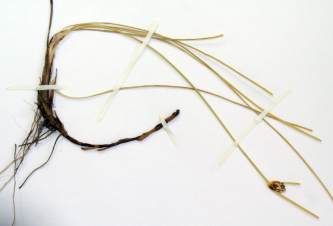
Ficinia pygmaea Boeck.
F. pygmaea is a low-growing, hairless, rhizomatous species. The rhizome is covered in pale brown scales. The stems stand solitary; each stem possessing tufted leaves that are chanelled near the base. The flower head has many pale brown spikelets. The species is known from lower mountain slopes in the Clanwilliam District.
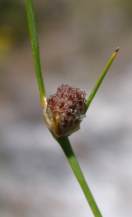
Ficinia dunensis Levyns
F. dunensis is endemic to the Western Cape where it is widely distributed, occuring in sand dunes or loose sand. Plants grow up to 200 mm high, possess horizontal stems and have leaves and aerial stems in small tufts. The horizontal stems are covered with dark brown scales when young and with age they become naked and wiry. The leaves are usually half as long as the flowering stems; the leaf sheaths are firm and deep red with the apex squared at the end. Leaf blades are thread-like. One to three spikelets occur in a compact terminal head that is enclosed by two sheathing bracts with wide, dark red-brown bases and leafy tips. The gynophore disc is well developed and lobed. Flowers are produced between August and October.
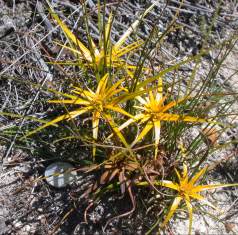
Ficinia radiata (L.f.) Kunth
Ficinia radiata is considered to be one of the most spectacular species of the Cyperaceae and is distinctly 'ficinioid' in appearance. Plants grow together to form a beautiful tufted display, each tuft comprising up to twenty individuals. The flower heads are located at the ends of culms (stems) and reach 150 mm in height. The bracts of the flower head are bright yellow and radiate spirally outwards, resembling a yellow star, hence the common name star grass.
The gynophore disc is large and well developed. The most significant difference between this species and other species of the genus Ficinia lies in the style branch that is markedly reduced so that the style is either unbranched or with three minute notches. The species grows in the southwestern region of the Cape Province where it is distributed from the Ceres Mountains southwards to Cape Town and the Western Cape. It grows on sandy lowlands and lower mountain slopes at altitudes between 200 and 2500 m. Flowering time is from September to December.
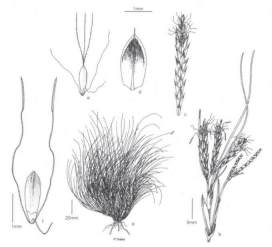
Ficinia esterhuyseniae Muasya
F. esterhuyseniae grows in moist rock crevices in sheltered overhanging rocks in the Western Cape from Swellendam to Clanwilliam at higher altitudes. It is a small, slender plant, growing in tufts with brownish leaf sheaths and leaves that are longer than the culms. The spikelets are cylindrical in shape.
The species is named after Miss Elsie Esterhuysen, a well-known plant collector who collected large amounts of material of Ficinia that is of much use to those attempting to understand the genus. Few other botanists have collected the species, perhaps because of its minute size and specialized habitat. The species is uncommon and if it were not for Elsie Esterhuysen's collections, it would have been poorly collected. Little is known about population size or distribution.

Ficinia micrantha C.B. Clarke
F. micrantha is a rare peninsula endemic, known only from damp peaty places on Table Mountain. Not many collections of this species have been made; the most recent collection is from a population that is now extinct because of a dam construction. The species grows up to about 120 mm high. Leaves are basally located and about half the length of the flowering stems. Leaf sheaths are firm and do not possess ligules. Leaf blades are flat just above the sheath and become cylindrical higher up. There is a single pale spikelet subtended by about six bracts, the lower of which is stiff and leaf-like and appears as a continuation of the stem.

Ficinia quinquangularis Boeck.
This species possesses densely tufted stems with a head of 1-4 chestnut-red spikelets. The upper sheaths are lance-shaped and leafless, whereas some of the lower sheaths bear leaves. It is known from rocky outcrops in mountain fynbos where it occurs from Swellendam east to the Outeniqua Mountains and also further east in the Tsitsikamma Mountains near Humansdorp.
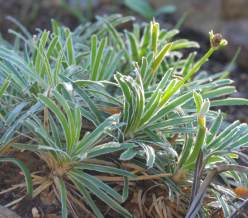
Ficinia truncata Schrad.
A hairless species with rigid horizontal stems covered in a dense array of hard brown scales. Over time the horizontal stems harden to form wiry rhizomes. The stems are 10-30 cm long and fairly rigid. Each stem holds a single rounded flower head. Leaves are flat, thick, parallel-sided and squared-off at the tip. The leaf margins are white and wear away, appearing tattered and membranous. The gynophore disc is rather long and narrow and its margin has three small teeth.
F. truncata occurs in the Riversdale, Mossel Bay and Uitenhage areas.
The species is popular in horticulture.
Plant Attributes:
Plant Type:
SA Distribution:
Soil type:
Flowering season:
PH:
Flower colour:
Aspect:
Gardening skill:
Special Features:
Horticultural zones
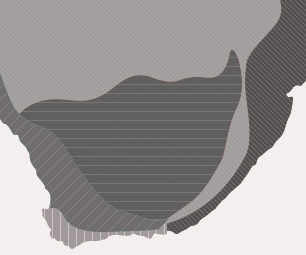





Rate this article
Article well written and informative
Rate this plant
Is this an interesting plant?
Login to add your Comment
Back to topNot registered yet? Click here to register.